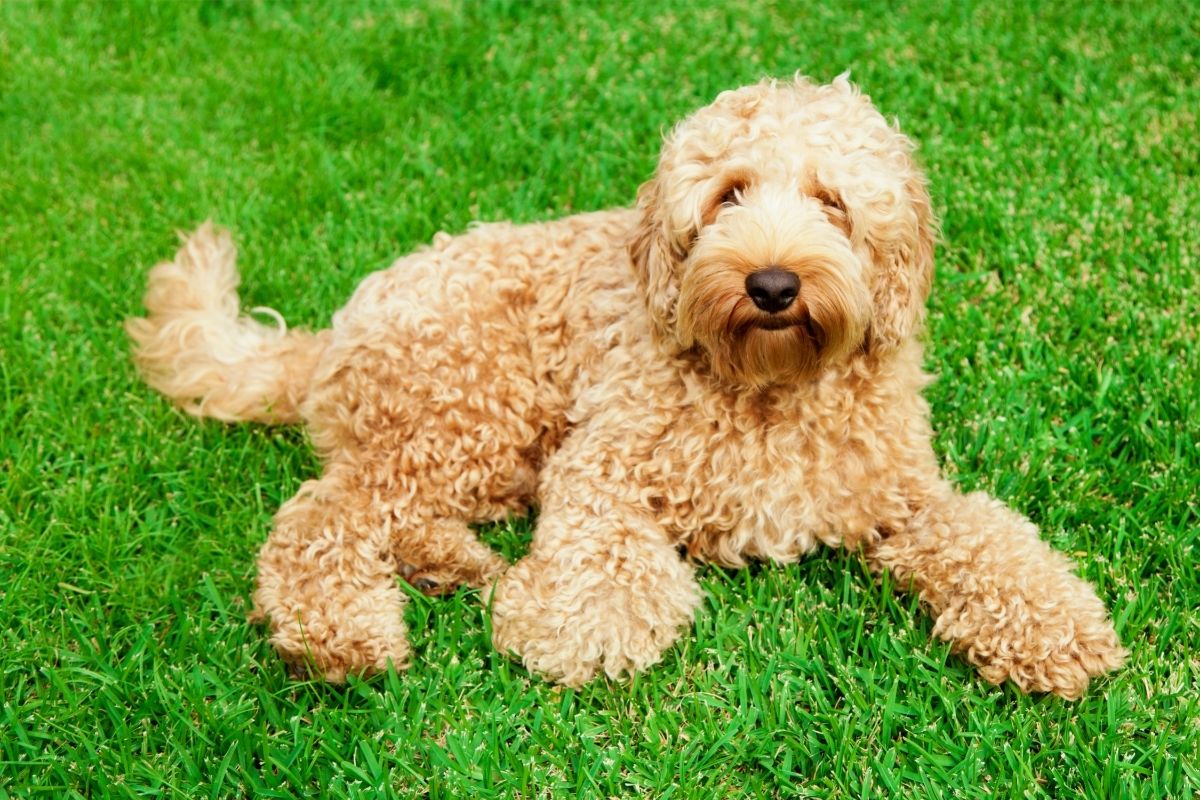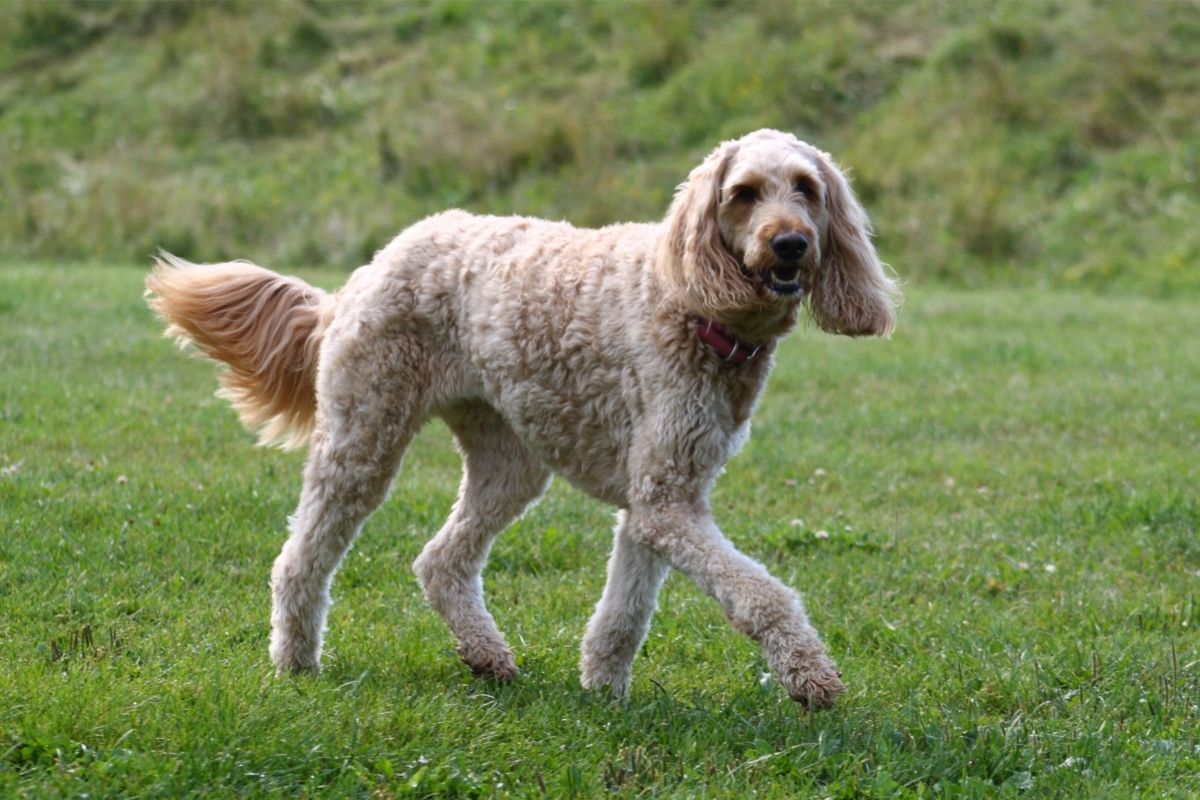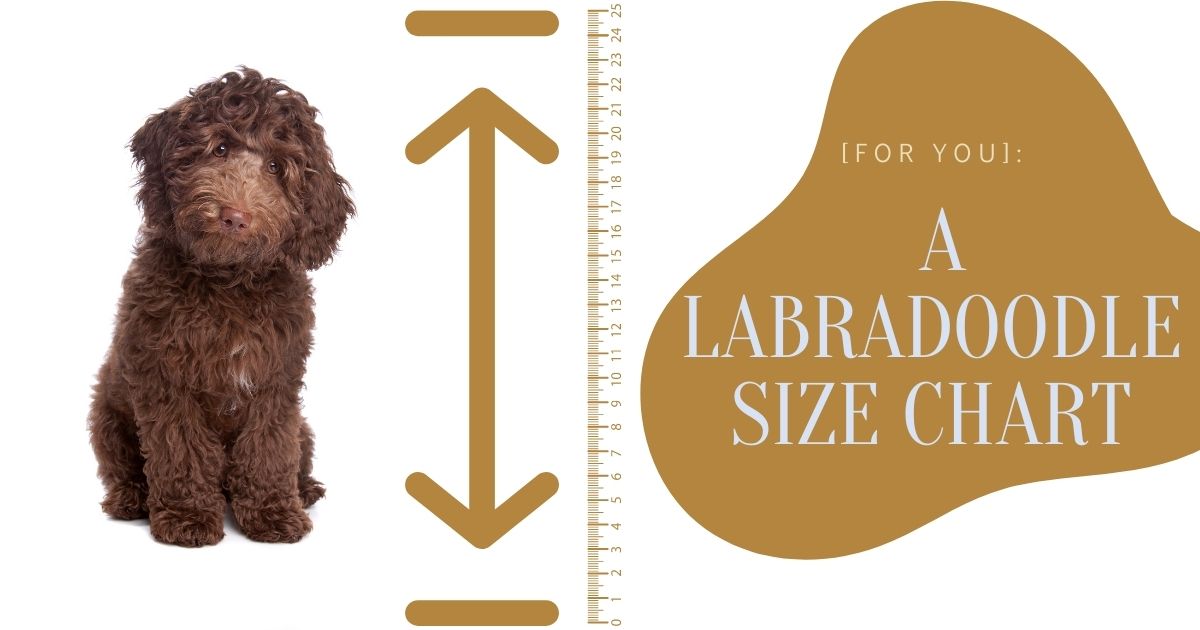How Big do Labradoodles Get?
If you are a new owner of a Labradoodle puppy, you may be asking how large Labradoodles get when they are fully grown. Due to this doubt, you may need a Labradoodle size chart.
You may have seen how quickly your puppy grows in the first 11-12 months of owning it, which may have worried you. Let us discuss about it.

Labradoodle Sizes
To get the correct answer to this question, you must first evaluate the sort of Labradoodle you own, as there are three different sizes. Each of the three Labradoodle sizes has an average size range where you can assess your puppy’s development.
From paw to shoulder, the Standard Labradoodle, the largest breed, can grow to be 21-24 inches (53.34-61 cm) tall. They’re the offspring of a Labrador Retriever and a Standard Poodle. The medium Labradoodle can reach a height of 17-20 inches (43.2-50.8 centimeters). They are a cross between a midsize Poodle and a Labrador Retriever parent.
A Miniature Labradoodle can be anywhere from 14 to 16 inches tall (35.6 to 40.6 centimeters), about the size of a human palm! They are a cross between a Labrador Retriever and a tiny Poodle. As a result, the size of a Labradoodle is highly dependent on the Poodle’s parent and breeding program.
A normal Labradoodle can weigh as much as 65 pounds (29.5 kilograms). A Medium Labradoodle may weigh 30 to 45 pounds (13.6-20.4 kilograms), whereas a Miniature Labradoodle may weigh 15 to 25 pounds (6.8-11.4 kilograms). The Toy Labradoodle weighs between 13 and 20 pounds (5.9-9 kilograms).
Teacup Labradoodles are even smaller than toy Labradoodles, weighing less than 13 pounds (5.9 kilograms). The colors range from black to chocolate to crimson to silver to a combination of tones.
Labradoodle fur comes in a variety of colors. They usually have wavy coats, but others have curly, wiry, or straight hair. They don’t usually shed their coats, but a few do so with less dog odor.
Your dog will not grow to the size of many other giant dog breeds, but they may grow to be larger than you anticipate. If you want to know how big your Labradoodle will be when they are fully grown, you can get a DNA test performed by a veterinarian.
You may also get an at-home DNA test to determine how big your Labradoodle will get. There are numerous credible DNA tests available.
When do Labradoodles Stop Growing?
Because Labradoodles are a crossbreed of Poodles and Labrador Retrievers, it can be challenging to predict their size. Many people do DNA tests to see the genes they got from their parents. A labradoodle growth chart can also help you forecast how big your Labradoodle will be when they are fully grown.
Remember that Labradoodles are available in three sizes: tiny, medium, and standard. Labradoodles are fully developing when they reach the age of 12 months and have reached roughly 97 percent of their full upper-body weight.
Even though they may still have a few pounds (kilograms) to add, we consider them fully developed. They would also have reached their full-grown height at 12 months.
Your Labradoodle puppy will be roughly 25% of their body weight at six weeks, half of their whole body weight at 14 weeks, 75% at 25 weeks, and 97 percent of their total body weight at one year.
Check at their parents if you want to figure out what size your Labradoodle will grow to be. Because heredity is a factor, this is one of the most accurate techniques to estimate their growth. Labradoodle puppies are typically the same weight and height as their parents. Labradoodle females are always roughly 5% smaller than their male counterparts.
A Labradoodle Size Chart
The table below provides an estimate of your Labradoodle’s weight and height. In many cases, the height and weight of the Labradoodle may differ from what you will find in the Labradoodle weight chart. In most circumstances, this is normal.
If you see your dog’s weight is significantly lower than any of the values on the Labradoodle size chart, you should evaluate his health. If your Labradoodle is too little, it may be more susceptible to various health issues.
It is critical to understand when your Labradoodle has reached adulthood. For them to be healthy and function correctly, Labradoodles must maintain a weight that corresponds to their height.
When it comes to keeping track of your dog’s size, BMI and growth charts are helpful. Humans observe them for the same reason. It’s also crucial to remember that if your Labradoodle’s weight or height exceeds any of the numbers in the chart, you shouldn’t worry.
Although your Labradoodle may not be in the ideal weight range, a few pounds (kilograms) overweight is OK. Use this chart as a reference, but keep in mind that it won’t work in every situation. Make sure to consult your veterinarian if you detect anything unusual.
| Miniature Labradoodle | Medium Labradoodle | Standard Labradoodle | |
| Height (At the Shoulder) | 13 to 17 inches (33 to 43 centimeters) | 17 to 20 inches (43 to 51 centimeters) | 20 to 26 inches (51 to 66 centimeters) |
| Weight | 15 to 25 pounds (6.8 to 11.3 kilograms) | 25 to 50 pounds (11.3 to 22.6 kilograms) | 50 to 90 pounds (22.6 to 40.8 kilograms) |
| Adulthood | 11 to 13 months | 11 to 13 months | 12.5 to 16 months |
How Much do Labradoodles Weigh?
The parents entirely determine the size of an adult Labradoodle. Let’s pretend you didn’t want a big dog. If that’s the case, you’ll get relief to learn that many classify Labradoodles as medium-sized dogs. It’s important to remember that a fully developed Labradoodle never exceed 24 inches (60.9 centimeters) in height.
When choosing this breed, inquire about the parents’ size with the breeder or veterinarian. This information will help you estimate the size of your Labradoodle when it grows up.
The mini Labradoodle (the minor variant of the breed) results from a mix between a Miniature Poodle and a Labrador Retriever. Adult males typically outweigh adult females by 10 to 15 pounds (4.5 to 6.8 kilograms) in these situations; however, this isn’t always the case.
Food, birth order, feeding pattern, and health are all factors that might affect adult weight. However, the size of each parent has a considerable impact on the size of your dog. The more similar the parent dogs’ sizes are, the easier it is to anticipate your Labradoodle’s mature size.
Because of its hybrid nature, determining the exact size of a Labradoodle puppy as an adult can be difficult. When two pedigrees combine, each pup inherits a unique set of genes. Some puppies, for example, may resemble Labrador Retrievers, while others may resemble Poodles in appearance and demeanor.
This is why it’s impossible to know precisely how each pair of genes will affect a puppy in a particular litter.
Labradoodle Weight Chart
| Age | Mini Labradoodle | Medium Labradoodle | Standard Labradoodle |
| 2 months | 10 pounds ( 4.5 kilograms) | 14 pounds (6.4 kilograms) | 20 (9.1 kilograms) |
| 3 months | 14 pounds (6.4 kilograms) | 18 pounds (8.2 kilograms) | 26 pounds (11.8 kilograms) |
| 4 months | 17 pounds (7.7 kilograms) | 22 pounds (9.9 kilograms) | 33 pounds (14.9 kilograms) |
| 5 months | 20 pounds (9.1 kilograms) | 29 pounds (13.2 kilograms) | 40 pounds (18.1 kilograms) |
| 6 months | 23 pounds (10.4 kilograms) | 34 pounds (15.4 kilograms) | 46 pounds (20.9 kilograms) |
| 7 months | 25 pounds (11.3 kilograms) | 37 pounds (16.8 kilograms) | 50 pounds (22.7 kilograms) |
| 8 months | 26 pounds (11.8 kilograms) | 39 pounds (17.7 kilograms) | 53 pounds (24.1 kilograms) |
| 9 months | 27 pounds (12.2 kilograms) | 41 pounds (18.6 kilograms) | 55 pounds (24.9 kilograms) |
| 10 months | 28 pounds (12.7 kilograms) | 42 pounds (19.1 kilograms) | 57 pounds (25.9 kilograms) |
| 11 months | 29 pounds (13.2 kilograms) | 43 pounds (19.5 kilograms) | 57 pounds (25.9 kilograms) |
| 1 year | 29 pounds (13.2 kilograms) | 44 pounds (19.9 kilograms) | 58 pounds (26.3 kilograms) |

The Different Sizes of Labradoodle Explained
Mini Labradoodle Size
A mini Labradoodle is typically between 14 and 16 inches (35.6 and 40.6 centimeters) tall and weighs 20 and 29 pounds (9.1 and 13.2 kilograms). An average eight-week-old tiny labradoodle puppy weighs between 8 and 12 pounds (3.6 and 5.4 kilograms). Your options have limits if you have a teacup Labradoodle, a Micro-Labradoodle, a toy Labradoodle, or a little Labradoodle.
Your full grown Labradoodle will weigh around 30 pounds (13.6 kilograms), and at 14 weeks, it will weigh roughly 17 pounds (7.7 kilograms). Around week 25, your tiny Labradoodle will be 75 percent of its full size. At the one-year point, 97 percent of their body size and weight will change.
Medium Labradoodle Size
Males should be 18 to 20 inches (45.7 to 50.8 centimeters) tall, while females should be 17 to 19 inches (43.2 to 48.3 centimeters) tall, and both should weigh around 30 to 45 pounds (13.6 to 20.4 kilograms). Mini Labradoodles grow more slowly than medium Labradoodles, which have a bigger overall size.
At eight weeks, medium-sized Labradoodles typically weigh between 13 and 15 pounds (5.9 and 6.8 kilograms). Your medium Labradoodle will be 50% of its entire body weight by week 13. At 24 weeks, they will have gained 75% of their total weight. At week 52, they will be near full maturity.
Standard Labradoodle Size
A female standard Labradoodle should stand 21 to 23 inches (53.3 to 58.4 centimeters) tall, and a male should stand 22 to 24 inches tall (55.9 to 60.9 centimeters), both weighing 50 to 60 pounds (22.7 to 27.2 kilograms).
The weight of a Standard Labradoodle varies greatly, and they are the giant breed. Standard Labradoodles can weigh anything from 60 to 90 pounds (27.2 to 40.8 kilograms).
Standard-size Labradoodle puppies typically weigh 15 to 20 pounds (6.8 to 9.1 kilograms) at eight weeks old. The ordinary Labradoodle weighs between 45 and 60 pounds (20.4 and 27.2 kilograms) when fully grown. During their first year of life, standard Labradoodles grow quickly. They will have gained 97 percent of their adult body weight by the time they are 12 months old.
It’s also worth noting that Labradoodles come in a wide range of sizes. Some may turn out to be smaller or larger than anticipated.
Factors That Determine the Size of a Labradoodle
Genetics
Because Labradoodles are crossbreeds of Poodles and Labrador Retrievers, hereditary variables significantly impact their size. Both parents’ genetic factors influence the rate of growth. Other essential elements, such as hereditary illnesses, also contribute to their development.
For example, if both parents are large, the kids will be as well. The dog will be about the same size as its parents when fully grown.
Nutrition
The sort of food you feed your Labradoodle puppy will influence its growth ability. More nutritious food has all of your dog’s nutrients to grow larger and stronger. You may also need to give your Labradoodle vitamins to help them stay healthy.
These are primarily for extreme circumstances where your dog is severely underweight or malnourished and requires extra assistance to reach its average size and weight.
Health and Physical Activity
Labradoodles were initially hypoallergenic guide dogs. They enjoy spending time with people and getting plenty of exercise, which helps them reach developmental milestones. The stimulation of the growth and development of bone density requires several activities.
When your Labradoodle exercises regularly, he will develop healthy, powerful muscles. Excessive physical activity in Labradoodles can cause hip and elbow dysplasia; therefore, it’s crucial not to overdo it. This damage could stunt their growth and cause other problems.
Labradoodle Growth Patterns
Birth to 2 Weeks
Due to their sensitive state, Labradoodles cannot care for themselves when they are born. They will seek comfort, warmth, and nourishment from their mother.
Puppies are born close to their mothers, but because their muscles have not yet matured, they cannot walk. To survive, they need the right temperature. Puppies require this time with their mothers to develop appropriately.
3 Weeks to 12 Weeks
At 3-12 weeks, your Labradoodle will go through many changes as its muscles get stronger. They are fully weaned at around 28-30 days old and have sharp teeth. Most Labradoodle mothers would wean their puppies on their own.
4 Months to 6 Months
The Labradoodle puppy will be teething at this time. The Labradoodle male weighs 10 pounds (4.5 kilograms) for the smallest dogs and 65 pounds (29.5 kilograms) for the largest dogs at six months of age. Female Labradoodles are five percent smaller at six months than males.
7 Months to 9 Months
Your Labradoodle will enter the heat cycle at this point, which will last around 4-8 weeks and make the females viable. Still, she shouldn’t be giving birth at this time. Because they have not completed their development, young puppies are not emotionally or physically ready to give birth.
A female Labradoodle’s body, on the other hand, is constantly maturing and preparing to give birth. When Labradoodles are nine months old, they usually have their first heat.
10 Months to 12 Months
Your Labradoodle is highly active at this stage, interested in exploring the environment and learning boundaries. Unfortunately, this is when families become aware of their dog’s behavior. This is the perfect time to teach your dog good habits. Later on, you will thank yourself.
Adult
The Labradoodle male and female will reach the age of one year. A fully matured Labradoodle is slim and compact with a thick coat. They are well-proportioned and lively, with a kind disposition. Many Labradoodles will continue to grow muscle until they are eighteen months old.
Labradoodle Weight Chart by Age
If you’re the happy owner of one of these puppies, you might be wondering how large they’ll get and when they’ll stop growing. Our Labradoodle growth chart will show you how much weight they will gain at each growth stage. Everything you need to know about Labradoodle puppy development is right here.

Labradoodle’s Rock!
This Labrador Retriever and Poodle mix is a good family dog and is popular with allergy patients due to its low shedding. The popular Labradoodle is highly trainable and, unlike some other dogs, is an excellent choice for first-time dog owners. These larger dogs can take up a lot of room, but they’re fantastic with kids and adapt to their family’s lifestyle.
The standard variety, which is a Lab crossbred with a standard-sized Poodle, may reach heights of 24 inches (60.9 centimeters) and weighs 75 pounds (34 kilograms). If you’re looking for a smaller dog, Mini-Labradoodles, a cross between a Labrador Retriever and a Miniature Poodle, are available.
Doodles are a pleasant addition to any family because they are loyal and loving. They enjoy playing with the baby and are prone to zoomies. Labradoodles are healthy dogs who require exercise, yet how much they run, play or swim depends on their Labrador and Poodle genetic mix.
